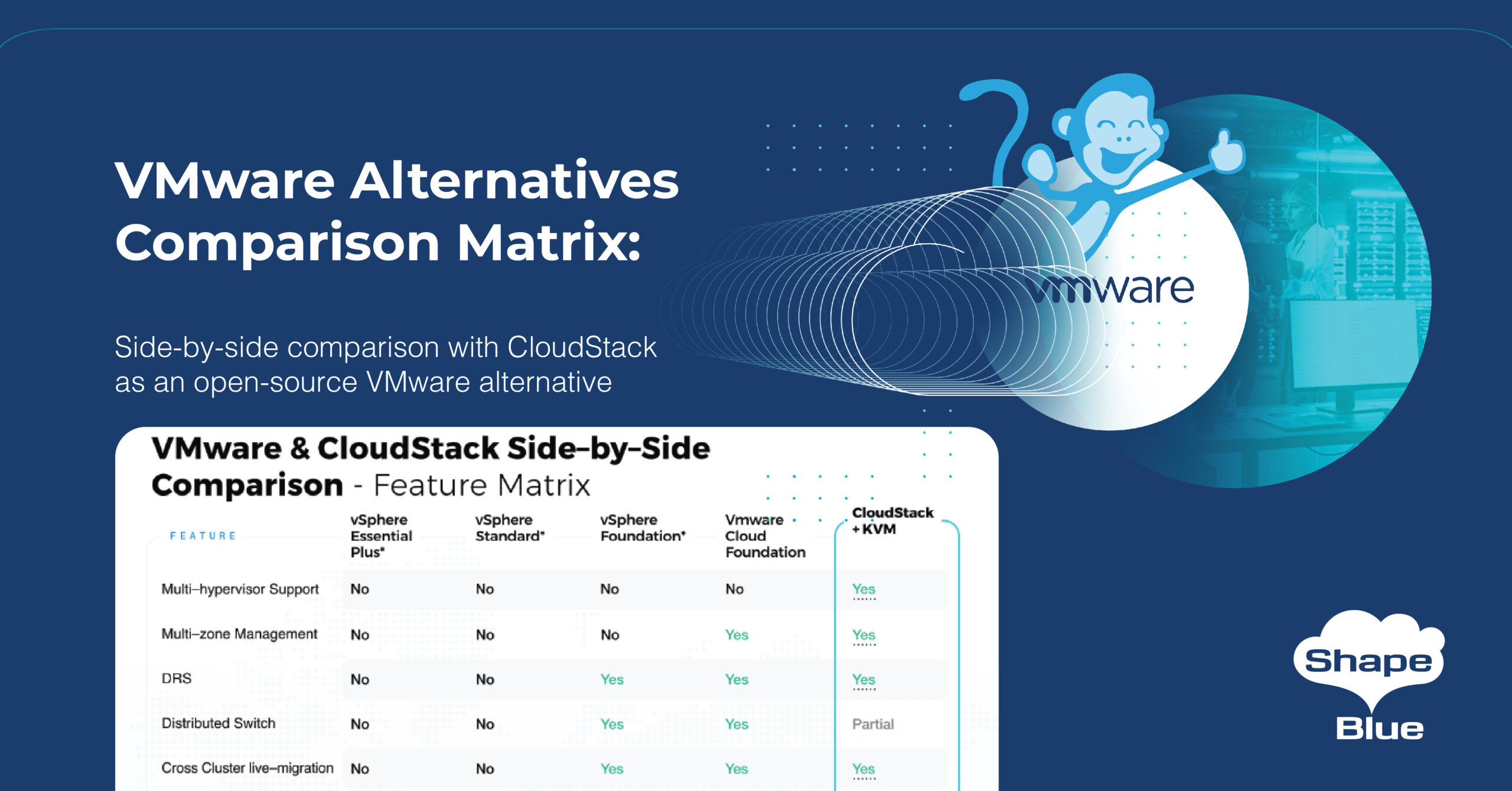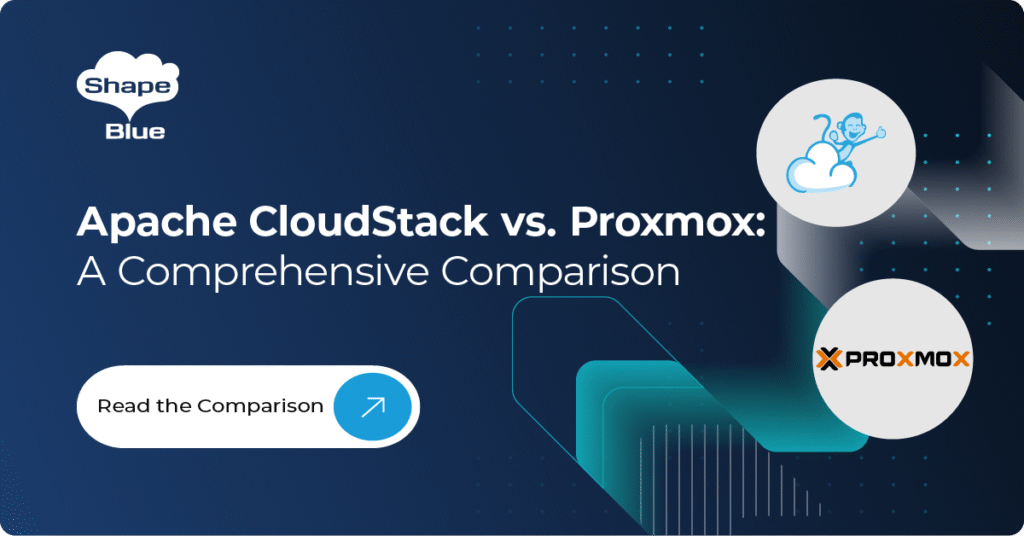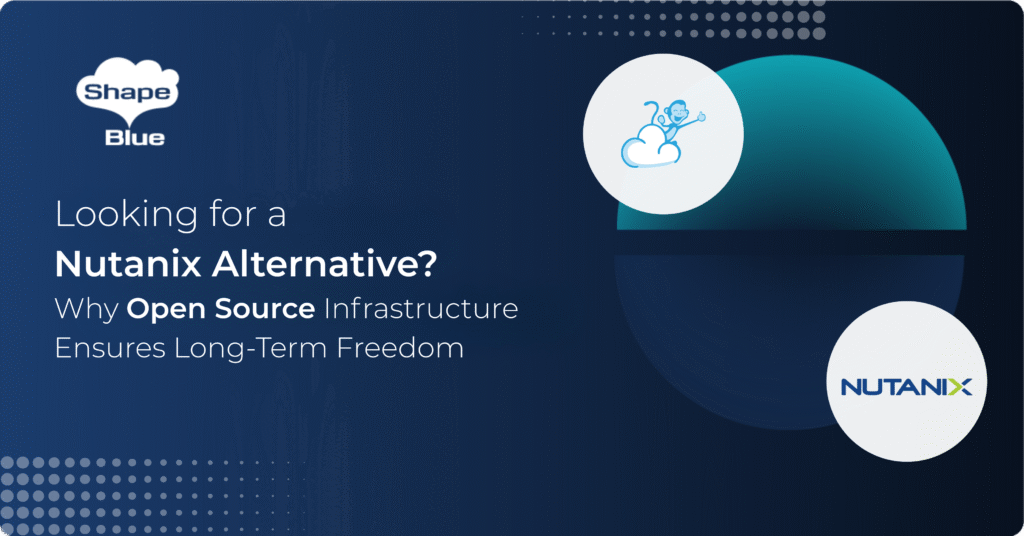After the announcements of price increases and the end of the availability of many VMware products, existing VMware users are evaluating and comparing different technologies in an attempt to find the best VMware alternative fitting their needs in the long term. The Apache CloudStack project is observing a massive interest from cloud and managed service providers as a full-featured open-source VMware alternative. In this article, we decided to make a side-by-side VMware alternatives comparison between the capabilities of Apache CloudStack and the two new Broadcom offerings – VMware Cloud Foundation and vSphere Foundation. For both products, VMware/Broadcom is promising that they will help cloud providers optimize their data centres, accelerate innovation for DevOps, boost operational efficiency, and ensure performance, but at a considerable price per core. The licensing cost both for VMware Cloud Foundation and vSphere Foundation claims to be attractive pricing to migrate from a perpetual license, but after doing careful calculations, cloud providers find out that they end up paying up to 300% more than what they have paid so far.
The logical move by many companies nowadays is exploring VMware alternatives to ensure their long-term reliability and profitability. At ShapeBlue, we work overwhelmingly with organisations who recognize that open-source technologies are the most secure path towards achieving such reliability and profitability. We focus on Apache CloudStack so we have made a side-by-side comparison between the old VMware offerings, VMware Cloud Foundation, vSphere Foundation and Apache CloudStack and KVM. Our goal is to demystify the transition process to a new platform by providing a detailed comparison of the features in the different options currently available to VMware users. This analysis is rooted in our understanding that changing platforms can be daunting and full of uncertainty about compatibility, performance and cost-effectiveness. Through our feature comparison, we aim to mitigate these concerns, providing insights and guidance to businesses as they navigate the complexities of choosing a cloud computing and virtualization platform that aligns with their strategic goals and operational needs.
In this analysis, we embark on a detailed exploration of the features offered by VMware’s suite of products in comparison to those provided by CloudStack’s open-source platform, which leverages KVM for virtualization purposes. It is important to recognize from the outset that the comprehensive range of functionalities available through VMware’s offerings might not be entirely matched by the open-source CloudStack suite, but, in the meantime, it adds other features without additional costs that can make a difference to organisations and unleash the potential of vendor lock-in businesses.

It’s important to note that VMware’s full feature set, while impressive, may not be fully utilized by many organizations. Some of VMware’s advanced features, though potentially beneficial for complex or large-scale operations, might exceed the needs or available resources of smaller and medium-sized organizations or those with more streamlined operations.
CloudStack aims to provide a robust yet potentially more accessible and cost-effective solution for cloud computing and virtualisation. By focusing on the key functionalities that are most required and utilised, CloudStack presents an alternative that, for most organisations, could align more closely with their operational requirements and budgetary constraints without overwhelming them with unnecessary complexity.
VCF Feature Comparison and Overview of the new VMware Bundles
Following Broadcom’s acquisition of VMware, we’ve compiled VMware’s new product offerings. These insights provide a foundation for understanding how VMware is adapting to Broadcom to reshape its licensing and subscription model to ensure profitability in years to come. It is important to note that Broadcom, in addition to changing the portfolio, also decided to end perpetual licensing and start charging subscriptions per core CPU and no longer for the socket CPU, changes that will deeply affect short-term prices for existing customers on their renewals and medium-term for new customers.
Additionally, Broadcom decided to terminate the “VMware Partner Connect Program” https://www.shapeblue.com/vmware-cloud-service-providers-program-terminated-whats-next-for-cloud-service-providers/, bringing great concerns and uncertainties to all cloud providers except the huge ones.
The new VMware’s offerings include the following options:
-
vSphere Essential Plus
It remains the entry-level solution tailored for small organizations that require core virtualization capabilities. This package includes vCenter and ESXi to support workloads efficiently and is sold per 96-core kit, a configuration that offers the simplicity needed by smaller operations.
-
vSphere Standard
Builds upon the Essential Plus package, offering per-core scalability. This allows for flexibility and growth, catering to businesses that need a more customizable approach to virtualization as they expand.
-
vSphere Foundation
It has been refashioned into a robust enterprise workload platform, providing a suite of essential tools, including vSphere for virtualization, Tanzu Kubernetes Grid for container orchestration, vCenter for management, vSAN for storage, and the Aria Suite Standard for operations management. This bundle is further enhanced with optional add-ons for expanded storage, disaster recovery, and security capabilities, illustrating VMware’s commitment to comprehensive enterprise solutions.
-
VMware Cloud Foundation
Stands as VMware’s premier offering, encompassing all the elements of vSphere Foundation with additional layers of networking through NSX, cloud connectivity via Hybrid Cloud Extension, and SDDC Manager for an integrated software-defined data center experience. VCF is engineered to deliver an enterprise-class hybrid cloud solution that brings together the flexibility of the public cloud with the control and security of private cloud environments.
Overview of Apache CloudStack and KVM Hypervisor
Apache CloudStack and KVM have a strong appeal for organizations looking for an alternative to manage and deploy cloud services because they are robust, highly scalable, open-source technologies. It is multi-tenant from the ground up. Unlike VMware’s approach, organizations can take advantage of everything needed in a single stack capable of running tens of thousands of Virtual Machine Instances and virtualizing the adjacent infrastructure in a multi-tenant environment, providing an efficient and highly scalable cloud computing platform. Both technologies make room for the partial or complete removal of VMware dependency, being a solution that puts organizations back in the game.
Apache CloudStack supports multiple hypervisors, migration tools to convert VMware Virtual Machines into KVM Instances, ingestion of existing vSphere and KVM infrastructures, container orchestration with Kubernetes and Cluster API for hybrid cloud environments, 3rd party VNF, DRS, self-service portal and API, and many other features.
For an in-depth exploration of Apache CloudStack as an alternative to VMware, including a detailed review of its features that facilitate the transition away from VMware, visit our comprehensive article here.
VMware Alternatives – VMware and CloudStack Side-by-Side Comparison – Feature Matrix
| vSphere Essential Plus | vSphere Standard | vSphere Foundation | VMware Cloud Foundation | Apache CloudStack | |
| Multi-hypervisor Support | No | No | No | No | Yes |
| Multi-zone Management | No | No | No | Yes | Yes |
| DRS | No | No | Yes | Yes | Yes |
| Distributed Switch | No | No | Yes | Yes | Partial |
| Cross Cluster live-migration | No | No | Yes | Yes | Yes |
| Cross DC live-Migration | No | No | Yes | Yes | Partial |
| Storage live-migration | No | No | Yes | Yes | Yes |
| High Availability | Yes | Yes | Yes | Yes | Yes |
| Kubernetes Support | No | No | Yes | Yes | Yes |
| Self-Service | No | No | No | Yes | Yes |
| Disaster Recovery | No | No | Add-on | Add-on | Partial |
| SDN Integration | No | No | No | Yes | Yes |
| SDS Integration | No | No | Yes | Yes | Yes |
| Multi-Cloud | No | No | No | Yes | No |
| Hybrid Cloud | No | No | Yes | Yes | Yes |
| Capacity Analytics | No | No | Yes | Yes | Yes |
| Life Cycle Management | No | No | No | Yes | Yes |
| Firewall | No | No | Add-on | Add-on | Yes |
| Load Balancer | No | No | Add-on | Add-on | Yes |
| Usage Metering | No | No | No | Yes | Yes |
| Object Storage | No | No | Yes | Yes | Yes |
| Edge Zone Capabilities | No | No | No | Yes | Yes |
| VNF Orchestration | No | No | No | No | Yes |
* The combination of CloudStack and vSphere is also possible. In this case, the missed features will be included if the use of vSphere is considered.
The decision between VMware and Apache CloudStack with KVM is not just a matter of comparing functionality; it involves a strategic assessment of organizational priorities, including cost, scalability, flexibility, TCO, ROI and specific technology needs. For organizations that need to deal with these decisions, the resource matrix and detailed analysis provided serve as a critical resource, offering insights into how each solution aligns with different operational objectives and possible migration scenarios for VMware alternative technologies.
It is important to note that organisations need to implement a ready strategy that offers agility for the moment of decision-making, being ready to adapt to the most efficient technologies and platforms both technologically and economically. This agility will ensure operational efficiency and profitability and position them to capitalize on new opportunities in an ever-changing technology landscape, removing obstacles out of their control, as is the case with the changes implemented by Broadcom.
Marco Sinhoreli is a seasoned Technical Marketing Manager at ShapeBlue, with over 25 years of IT experience. As an Apache CloudStack expert and committer, he specializes in creating and delivering technical marketing content that bridges the gap between technology and business. Marco has consulted major companies on implementing IaaS solutions with CloudStack, focusing on delivering cloud infrastructure that supports both immediate and long-term business needs. When he’s not diving into cloud solutions, Marco loves playing guitar, exploring new places, and staying updated on politics.





